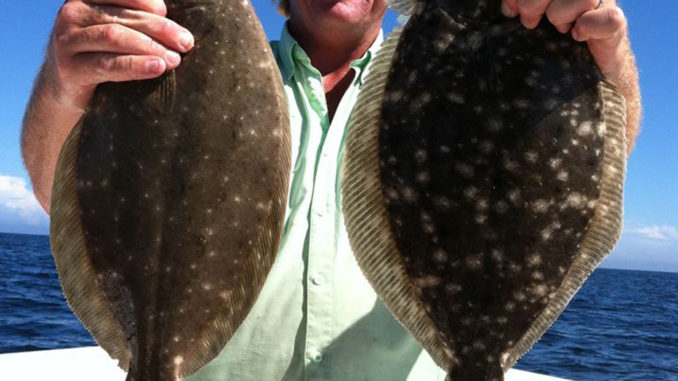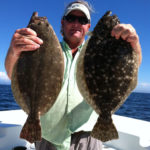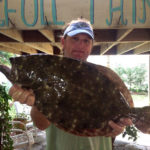
Anchor up around a nearshore reef, drop down a live bait and hang on for excellent flounder action
During the summer, Murrells Inlet’s blue waters and spectacular marsh walk draw a lot of people visiting the Grand Strand. From banana boat rides and water skiing to inshore anglers looking to score enough scaly fare for dinner, the beautiful estuary becomes a little congested, to say the least. Nevertheless, just a few miles from the jetties that line the entrance to the inlet lies some great flounder fishing, with doormat-sized fish comprising a lot of the take.
Nearshore reefs just off the pearly white beaches literally stack up with flounder, yet anglers will have plenty of elbow room to crank in a limit during the heat of the summer.
Yes, it’s the segment of the Atlantic population of flatfish known as the gulf flounder. Anglers can expect to catch them exclusively around nearshore and offshore reefs during the summer, leaving the hustle and bustle to the watersports companies inshore.
Gulf flounder require cooler water than their cousins, southern and summer flounder, which live at the jetties and inside Murrells Inlet estuary. The three species refer different salinities. Anglers fishing in the marsh and up tidal creeks will catch primarily southern flounder, since they prefer waters with lower salinity. Summer flounder prefer waters with slightly more salinity and will be caught both inshore and along the beachfront. Additionally, gulf flounder will run larger than to the inshore fluke population.
“The fish are so much bigger out there,” said Capt. Englis Glover of Tee to See Guide Service, who chooses ocean flounder fishing over the inshore version whenever conditions will allow it. “Last year, on one trip, I had 11 keepers over 19 inches, with the biggest fish weighing just over 5 pounds.”
Don’t head to the ocean expecting the typical soft and subtle bites of the inshore flounder. Gulf flounder are much more aggressive.
“In the ocean, they are more committed and much more aggressive,” Glover said. “As soon as you feel the take, or if it stops, you should set the hook immediately.”
Capt. J Baisch of Fishfull Thinking Guide Service is another fan of the summer gulf flounder bite and knows right when and where to find them.
“We start fishing for them in May and will catch them through November most years,” said Baisch. “You will catch one every now and then at the jetties, but they really like the wrecks in the ocean in deeper water.”
Gulf flounder require cool, high-salinity waters typical of the ocean. They are structure-oriented fish, and the underwater architecture displayed at these reefs comprises a perfect place to concentrate schools of doormat flukes.
Baisch chooses reefs that are well established.
“I like the reefs with good old growth and a wide debris field created from past storms,” he said.
These more-established reefs with scattered structure have more places for bait to hide, hence more ambush opportunities or flounder. Baisch will fish any reef structure from the nearshore 3-Mile reef to reefs in 80 to 100 feet of water.
Glover limits his flounder fishing to reefs closer to shore to avoid encounters with non-targeted species.
“I try to stay around the shallower reefs nearshore like the 3-Mile, Myrtle Beach Rocks, and the Pawleys Reef,” said Glover. “When the water warms up in summer, the black sea bass move off to the 10-Mile Reef and to deeper reefs, so your competition with black sea bass becomes less on the inshore realm in the 35-foot water versus the 50-foot water.”
Glover also targets places with natural structure and live bottom.
“Don’t overlook secret ledges from 50 feet and in; they will hold plenty of gulf flounder this time of year,” he said. “Any contour changes will usually hold bait, and the flounder will be there.”
Both Glover and Baisch will locate structure and fish areas immediately adjacent, as well as the sand within casting distance. Baisch positions his boat right top of the structure, casting away and fishing the sand around it.
“Bump the bottom and work the edges of the structure,” he said.
Baitfish will try to stay close to the structure for protection, and the flounder know this. But the current will affect the way fish position around the structure. Glover has better success when the current is moving.
“They like to have a current, and the bite is much better when the tide is moving strong. However, they will hold tighter to structure when current is running strong,” he said.
Strong currents prevent small baitfish from swimming freely, and any submerged structure that deflects current will give them places to hide. Flounder will hang out in those areas, waiting for their next meals to appear in plain sight, six inches away.
While flounder eat a wide variety of forage species, small fish make up their primary diet at the reefs. A live mullet minnow or mud minnow rigged on a Carolina rig or a jighead is still the best way to catch flounder. However, the lightest amount of weight is still preferred to allow live offerings to swim as freely along the bottom as possible, while staying close to the bottom.
In the ocean, Baisch and Glover prefer to use jigheads, because they allow anglers to pick up on every movement the baitfish or flounder makes. Both prefer a specialized jighead made by Fishizzle Lures that’s designed to stand straight up on the bottom and allow the minnow to swim in a more natural position.
“I use a 1/2-ounce Fishizzle Meal Ticket jighead because it stands up on its own,” Baisch said. “There are few jigheads that are able to stand up on their own, and this is very important to keep the minnow vertical and in a natural presentation.”
A standard Carolina rig will also suffice if the current is not too strong. Baisch suggests a 12- to 16-inch monofilament or flulorocarbon leader, a 1/2- to ¾-ounce egg sinker on heavier tides with an offset flounder hook or Owner Octopus circle hook.
DESTINATION INFORMATION
HOW TO GET THERE/WHEN TO GO — Murrells Inlet is at the southern tip of the Grand Strand. Its waters are easily accessible from a public boat ramp on US 17 Business just south of the heart of Murrells Inlet’s restaurant district and Crazy Sister Marina. Artificial reefs and wrecks out to 60 feet will hold gulf flounder all summer and well into the fall. Pawleys Reef, 3-Mile Reef, North Inlet Reef and Myrtle Beach Rocks are great spots to catch flounder in the hot months. Fewer black sea bass will be on the shallower reefs to steal baits intended for flounder. Good reefs in deeper water are the 10-Mile and 11-Mile reefs, Belky Bear and the Georgetown Reef.
TACKLE/TECHNIQUES — Anchor directly over reef structure and work baits slowly. Braided line in the 20-pound class is preferred because it provides greater sensitivity and lower stretch for hooksets. Live mud minnows or smaller mullet minnows are prime live bait, fished either on a half-ounce jighead or on a Carolina rig with a 1/2- to 3/4-ounce egg sinker and 12 to 16 inches of a 20- to 30-pound monofilament leader.
FISHING INFO/GUIDES — Capt. Englis Glover, Tee to Sea Guide Serivce, 843-655-5459, www.teetoseafishing.com; Capt. J Baisch, Fishfull Thinking Guide Service, 843-902-0356, www.fishthinkguidesc.com; Pawley’s Island Outdoors, 843-979-4666; Perry’s Bait & Tackle, 843-651-2895. See also Guides and Charters in Classifieds.
ACCOMMODATIONS — Murrells Inlet Hampton Inn, 843-651-6687; Myrtle Beach Area Convention and Visitors Bureau, www.visitmyrtlebeach.com; South Carolina Association of Visitors Bureaus, www.discoversouthcarolina.com.






Be the first to comment